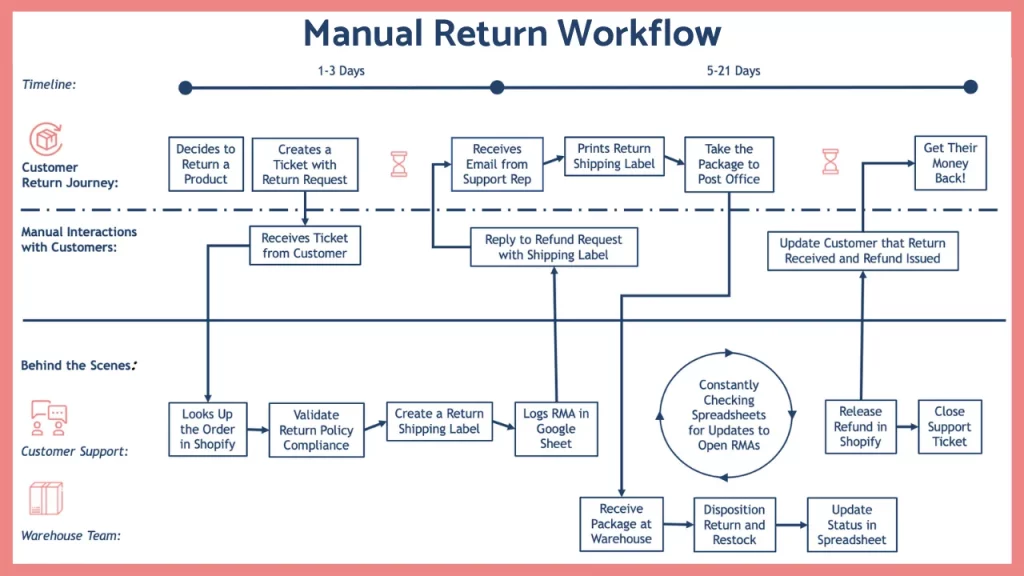The Perils of a Manual Ecommerce Return Process

Dichotomy of E-commerce Returns
In e-commerce today, there seems to be a vivid contrast between the massive players like Amazon, Alibaba, or Jet.com and everyone else. In few aspects is this separation is more apparent than return management.
The industry giants have entire teams dedicated to product returns – and not only a team in the warehouse.
An assembly of project managers, software developers, customer specialists, scientists, operations managers, and vendor partners optimize the return process to recover the maximum value of every item that comes back.
This optimization isn’t excessive. Returns are a complex problem in need of a sophisticated solution.

But not everyone is Amazon, and most companies can’t afford to dedicate billions of dollars to returns. Newer, growing e-commerce retailers are left to fend for themselves when it comes to product returns.
Without the resources, established processes, and technological systems, these companies can experience immense pressure in the reverse supply chain.
The burden often manifests itself as a costly, inefficient return management operation and a lackluster experience for the shopper.
Examining a Manual Return Process
If shoppers are buying, then they’re returning. We see that anywhere from 30% to 50% of shoppers return a product at some point in their customer lifespan. Without an effective system for returns, a sizable portion of shoppers can become disaffected.
Today’s shoppers are more demanding than ever. A seamless return process is the new movement of the customer experience.

The flow of a manual return process is often a case of siloed procedures and stifled communication.
Usually, the process begins with an email address or phone number listed on the website for the shopper to contact. After a series of communications, the retailer instructs the shopper to send the product back.
A point of friction for the retailer early on is trying to enforce their return policies.
Without sophisticated workflows in place, it can be quite a time-consuming task for customer service to confirm if the product and case at hand meet the criteria for a return.
It also creates a tradeoff between enforcing those rules and providing the customer with the best possible experience.
Nobody wants to give the shopper bad news. These forced calls create an unnecessary point of friction in the customer journey. By automating the enforcement of return policies, retailers can quickly relieve this issue.

Once the item arrives at the retailer’s location, a warehouse team member receives the product and records its arrival in a shared document.
From there, a customer service representative confirms the item is accounted for and goes to find the corresponding order in Shopify, their email, or a ticketing system – to initiate the exchange or refund.
Meanwhile, the warehouse team has to direct the product to its next destination – whether that be restocking back into the store’s inventory, selling through a secondary market, or simply disposing of it.
The entire process lacks integration between the various components. For example, it’s typically not brought to the attention of customer service when a product is received. And at that point, there’s no quick and easy way for the representative to find a record of the original order.
The result is an inefficient return process. For some retailers, it can take nearly two weeks to completely process a return. But with ReturnLogic, they can process returns in a matter of minutes.
In addition, it can be difficult for retailers to balance customer centricity with their policies and procedures. The manual return process can present a mess of difficulty for shoppers.
Using ReturnLogic, retailers don’t receive nearly the same volume of emails and tickets to their customer service team. Shoppers can initiate returns on their own with an easy and customizable interface.
Return management is notoriously one of the dark corners of e-commerce. But with operational visibility and automated rules enforcement, it doesn’t have to be.
It Works… Until it Doesn’t
A manual return process is never ideal for a retailer, but it often functions sufficiently enough for a while. The problem is, by the time its deficiencies become apparent, you’ve already been enduring the burden for some time.
As your brand grows, you would expect the pain of product returns to increase proportionally. However, more often than not, the pain you feel grows faster than your scale.
What once cost you just a couple thousand dollars can quickly escalate to tens or hundreds of thousands, and returns can no longer receive the same degree of individual attention.
As you prioritize customer service more heavily, the slow and inconvenient back-and-forth contact can’t keep up. On top of that, inefficient operations are a fundamental obstruction of growth.
Retailers frequently continue for too long with a manual return process because they’re unsure when to transition to return management software.
Getting Ahead of Returns
The good news is that solutions like ReturnLogic provide plenty of alternatives to a manual return process.
An investment in e-commerce returns automation is an investment in your business. The benefits in operations and customer experience will scale with your business.
The key is to be proactive. ReturnLogic strives to alleviate the burden of returns before it becomes detrimental to the retailer and scale with the retailer to continually provide value.
We’re not just here to help manage your returns – we’re here to help you grow your bottom line.






